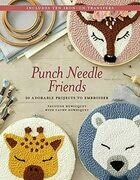Sample Projects
Meet the Author
Hey there, can you introduce yourself?

My name is Silke Bosbach, and I am a designer, lecturer and author known for my daring adaptations and modern interpretations of conventional design techniques. I studied Visual Arts at the University of Cologne before training in textile design and the last 19 years I have spent actively engaged in this field. I currently work as a freelance designer and as a teacher of Fine Art. I run private workshops on textile design and organize international trade and consumer exhibitions and awards. I have received various trade industry awards in Germany for my innovative work.
Tell us a bit about the book?
In the book I show you how to create 15 stunning embroidery designs which blend modern techniques with the simple and traditional Japanese method of Sashiko. Traditional Sashiko is a simple folk technique originally used for darning. While the conventional craft uses only a basic running stitch to create intricate patterned backgrounds, I show you how to adapt this basic style by applying modern surface finishes on numerous textiles and combining it with a variety of other techniques – for example Shibori. Explore the fascinating possibilities of these embroidery techniques yourself and be inspired to create your own unique combinations of the modern and the traditional.
What was the inspiration behind it?
Since my graduation I have been interested in Asian textile techniques, including Sashiko and Shibori.
Which is your favourite project?
My favourite projects are the three-dimensional Sashiko ones on felt and on knitted objects (knitwear).They are called “Floral relief” and “Wisteria”.
What is your craft space like?
My studio is situated about 30 km from Cologne, in the beautiful countryside of a rather rural region known as "Bergisches Land". It has floor to ceiling windows with a stunning view of fields and trees, and this is where I get the inspiration for my work.
Have you always been creative?
Yes, ever since my childhood. I grew up in a very creative family, with both my grandmothers as well as my mother and older sister interested in all kinds of needlework, especially embroidery, knitting and sewing.
When did you first start crafting?
Even as a child I liked painting very much, and was particularly inspired by the human form. At that time I also started sewing and crocheting outfits for stuffed toys and the like.
Who are your crafty heroes?
In my work I`m guided not by authors or crafty heroes. My motto is something former German Chancellor, Konrad Adenauer, once said: You have to see things so deeply that they are simple.
Where do you find inspiration?
Most of my inspiration comes from nature, from different landscapes like forests, mountains and the sea. There is no end to the wealth of shapes and colors that nature offers.
What's next for you?
Next year will be quite exciting, as far as textile projects go. There will be three creative textile awards (for example the “Textile Outdoor Award” with an textile art trail in Germany or the caritative project “a bag for charity”). Also there will be exhibitions as well, like at the German Museum in Munich with a view of crochet hyperbolic forms. You can find more detailed information on www.silke-bosbach.de and www.faser-um-faser.de









